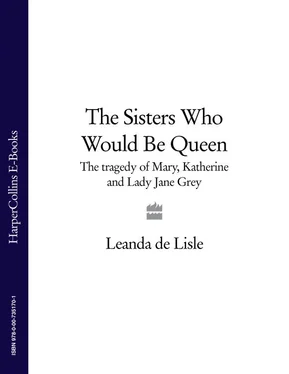Sudeley’s grief over his wife’s death had passed rapidly through the early stages of numbness and denial that follows bereavement. He now grasped it as fact, with all its implications. Her wealth was being returned to the crown. This dealt a severe blow to his finances and status. That could not be helped, but returning Jane to her parents was an act of political self-mutilation that he could yet rectify. Sudeley had written on 17th September pleading with Jane’s father for her return. He anticipated that Frances, in particular, would be unenthusiastic and assured Dorset that he would be keeping on Catherine Parr’s gentlewomen, the unmarried Maids of Honour, ‘and other women being about her Grace in her lifetime’. Everyone, Sudeley swore, would be, ‘as diligent about [Jane], as yourself would wish’. His own mother would take charge of the house, and would treat Jane ‘as though she were her own daughter. And for my own part, I shall continue her half father and more.’ 3 Sudeley then wrote to Jane in a suitably strict, fatherly manner. Jane, picking up her cue, thanked him reverently. ‘Like as you have become towards me a loving and kind father, so I shall be always most ready to obey your godly monitions and good instructions,’ she replied. 4
Frances was unimpressed, however, by Sudeley’s assurances and Dorset, aware that Sudeley’s status had fallen with the death of Catherine Parr, agreed with his wife that it would be better if Jane now stayed at home. Dorset wrote thanking him for his care of Jane thus far, and then reminded his friend that Jane was very young, and while he regarded him as an excellent father figure, he could not also be a mother to her. With Catherine Parr dead, Sudeley could surely see that ‘the eye and oversight of my wife shall in this respect be most necessary’. Jane was on the cusp of adolescence, a crucial age for ‘the addressing of the mind to humility, sobriety and obedience’. 5 Dorset concluded hopefully that he still intended to take Sudeley’s advice about Jane’s marriage.
Frances then wrote her own letter to Sudeley. As Jane’s guardian and the Queen dowager’s widower, Sudeley was a member of the family and Frances referred to him in her letter as her ‘good brother’ and to Jane as his ‘niece’. She also accepted that when it came to Jane’s marriage they would ask for his advice, as her husband wished. But she made it clear that she did not expect any marriage to take place for a good while yet. Having been married herself at sixteen, Frances did not want her daughter hurried into a husband’s bed. Frances concluded her letter expressing the hope that she could keep her daughter with his ‘goodwill’. 6 It was not to be. Within days Sudeley was on the road to Leicestershire determined to change their minds. When the sisters and their parents greeted him at Bradgate he also had a friend at his side, Sir William Sharington, the Under Treasurer of the Royal Mint.
Jane had seen Sharington often at Seymour Place, and Katherine and Mary may have remembered him from the previous autumn, when he had accompanied Sudeley to Bradgate on another visit. A handsome, charming man, he had an elegant, aquiline nose, though his eyes were dark-ringed and prematurely lined. Sharington had used his position at the Mint to perpetrate extensive frauds. 7 Sudeley knew what he had done and in exchange for his secrecy Sharington was providing him with money. This included the ready cash Sudeley needed to buy Jane’s wardship. But Sharington also had talents that Sudeley would make good use of at Bradgate. He could be extremely plausible. The previous autumn he helped persuade Dorset to vote with Sudeley against a bill in Parliament confirming Somerset’s letters patent as Lord Protector - Dorset had been the only peer to do so. Now Sharington had the task of persuading Frances to return her daughter to Seymour Place, while Sudeley worked on Dorset.
Sudeley knew his most effective leverage with Dorset remained the promise that he could deliver the King’s hand in marriage to Jane. And he had a piece of good fortune in this respect. Jane’s principal rival, the infant Mary Queen of Scots, had been sent to live in France so that she could be betrothed to the Dauphin, Francis. Sudeley assured Dorset that ‘if he might once get the King at liberty’ then he could immediately have Edward married to Jane. Dorset hummed and hawed, but, as he later recalled, Sudeley ‘would have no nay’. Sharington, meanwhile, was doing an excellent job at weakening Frances’s resolve, reassuring her that all her fears were misplaced. Eventually, ‘after long debating and much sticking’, she agreed that Jane should be returned to Sudeley’s care and her husband followed suit. 8 It was a decision they would soon regret, as would Jane.
Life at Seymour Place that autumn of 1548 was not as Jane remembered it, despite the comforting presence of her old friends from Catherine’s Privy Chamber. The Queen dowager’s stabilising influence on Sudeley was gone and a part of him had not quite accepted she was dead.
Sudeley spoke often of promoting a parliamentary bill that would prevent people slandering Catherine Parr’s name over her decision to marry him so quickly after Henry VIII’s death. But there were also rumours circulating that he wanted to remarry. Some claimed Sudeley had his eye on the Princess Mary, others that he hoped to marry Lady Jane Grey. He laughed at that suggestion, but admitted to his former brother-in-law, Parr of Northampton, that there would be ‘much ado’ for Jane’s hand. His ward would be twelve in May and able to make a binding marriage contract under canon law. He believed the Somersets, in particular, ‘would do what they could to obtain her for [their son] Lord Hertford’.
Northampton asked Sudeley if his real intention might be to marry the Princess Elizabeth rather than Jane. Sudeley replied that ‘he had heard that the Protector would clap him in the Tower if he went to Elizabeth’, 9 though he could see no other reason why he shouldn’t marry her, if she were willing. As he told other friends, it was far better that Elizabeth should marry within the kingdom than outside it. Elizabeth, however, had learned the lessons of the previous spring when Sudeley had embarrassed her with Catherine Parr. She was acutely aware that she could not marry without the permission of the King and the Privy Council, and refused even to see Sudeley without a warrant. But some of her servants were prepared to help him, believing, rightly or wrongly, that this was what Elizabeth truly wanted. Two or three weeks before Christmas, Jane noticed the familiar full face of Elizabeth’s cofferer, Thomas Parry, at Seymour Place. Parry, who as cofferer managed Elizabeth’s money, appeared several times, walking alone with her guardian in the gallery where, out of her earshot, they discussed the financial details of a possible marriage to Elizabeth. 10
Such dabbling in a matter of high state caused considerable alarm with other servants in Elizabeth’s household. The princess’s tutor, Roger Ascham, was so appalled by Parry’s actions that he asked for permission to return to Cambridge for the entire Christmas season. Kate Astley’s husband John, equally concerned, argued furiously with his wife over the arrangements. One of these arguments was so heated that afterwards Elizabeth noticed bruising on her governess’s arms (Astley claimed that a doctor had been bleeding her to cure some ailment). The atmosphere at Seymour Place, meanwhile, was equally charged. Sudeley’s friends and servants desperately tried to dissuade him from his course. It was against all sense of decency and right order that a man without royal blood should align himself with an heir to the throne. ‘Beware,’ one warned Sudeley: ‘It were better for you if you had never been born, nay, that you were burnt to the quick alive, than that you should attempt it.’ Men had died already for attempting royal alliances during King Henry’s time and it would put Elizabeth’s life at risk. 11 They begged him instead to improve his relations with his brother. But Sudeley only blustered about how he would use Parliament to get the Governorship of the King’s Person in spite of the Protector, and seize his rightful share of power.
Читать дальше












